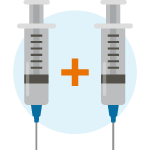Comparing the Pfizer and Moderna/Spikevax COVID-19 Vaccines
Both are revolutionary mRNA vaccines that are highly effective—94 to 95%—against COVID-19. But there are a few differences.
Safe, effective COVID-19 vaccines are here
Across the globe, pharma companies are racing to roll out safe, effective vaccines to combat COVID-19 disease. According to the World Health Organization (WHO), over 50 vaccines are now in trials, with seven receiving regulatory approval in various countries.
Here in the U.S., the Food and Drug Administration (FDA) has approved the use of two mRNA COVID-19 vaccines: The Pfizer BioNTech (Pfizer) vaccine and the Moderna Vaccine/Spikevax COVID-19 Vaccine (Spikevax).
Comirnaty by Pfizer received full authorization from the FDA for individuals ages 16 and older. It has also been granted emergency use authorization (EUA) for children 5-15. The Moderna Vaccine/Spikevax COVID-19 Vaccine (Spikevax) is fully authorized for use in individuals 18 and older.
The FDA is required to make decisions that are guided by science and data. The makers of these vaccines followed every necessary step to meet the FDA’s emergency authorization process. Both vaccines have been through a series of reviews and were rigorously tested for safety, effectiveness and quality.
Advances in science enabled the rapid development of these vaccines, which wasn’t possible just a few years ago. The federal government’s unprecedented investments also encouraged companies to start producing the COVID-19 vaccine sooner than is typical.
 Did you know?
Did you know?
Because the mRNA used in both vaccines is fragile, cold storage is required to ensure they are stable. Pfizer’s vaccine requires ultra-cold shipment and storage at -94⁰ F, compared to Moderna’s at -4⁰ F. This makes Moderna’s far less challenging to use than Pfizer’s, which requires special freezers. While both vaccines are shipped and stored frozen, they are thawed before injection.
Two different vaccines—one common goal
Although developed by different manufacturers, the two vaccines are very similar. Both are mRNA vaccines that “teach” the body to make the spike protein found on the virus. This protein triggers your immune system, which creates antibodies specific to COVID-19. These antibodies protect the body and help fight future infection.
The Pfizer vaccine showed 95% protection during a clinical trial of 44,000 participants. The Spikevax vaccine showed 94% protection in a clinical trial of 30,000. In comparison, the effectiveness of the common flu vaccine varies each year between 40% and 60%.
As reported in both the Pfizer and Spikevax trials, the level of effectiveness of each manufacturer’s vaccine was consistent across age, gender, race and ethnicity. Each trial included a range of white, Hispanic/Latinx, Black, Asian and multiracial participants.
| Comparing the Vaccines | Pfizer-BioNTech mRNA Vaccine |
Moderna Vaccine/Spikevax COVID-19 |
|---|---|---|
Doses and Timing |
Two doses, three weeks apart | Two-dose vaccine, four weeks apart |
Who can receive it |
Recommended for people ages 5 years or older | Recommended for people ages 18 years or older |
Storage |
Requires ultra-cold storage (-94⁰ F) | Requires standard cold storage (-4⁰ F) |
Available doses |
3 billion doses to the world in 2021 | 500 million to 1 billion doses to the world in 2021 |
Effectiveness |
Large-scale trial (44,000 participants) showed 95% protection from disease | Large-scale trial (30,000 participants) showed 94% protection from disease |
Giving COVID the one-two punch
 Both vaccines are given in a series of two injections. The first is a priming dose that prepares the immune system. The second is a booster shot that strengthens the body’s immune response.
Both vaccines are given in a series of two injections. The first is a priming dose that prepares the immune system. The second is a booster shot that strengthens the body’s immune response.
Pfizer’s vaccine requires the two doses to be given 21 days apart, while Spikevax’s doses are delivered 28 days apart.
Booster shots
Studies show that after getting vaccinated against COVID-19, protection against the virus may decrease over time. This lower effectiveness is likely due to the combination of decreasing protection as time passes since getting vaccinated and the greater infectiousness of variants.
Everyone 12 or older who received the Pfizer vaccine is eligible for a booster five (5) months after their primary series. Adults 18 or older who received the Moderna Vaccine/Spikevax COVID-19 Vaccine (Spikevax) are also eligible for a booster five (5) months after their primary series. The nearly 15 million people who received the Johnson & Johnson vaccine as their initial shot are eligible for a booster shot two (2) months after their last shot.
Eligible individuals may choose which vaccine they receive as a booster dose. Some people may prefer the vaccine type they originally received, and others may prefer to get a different booster. CDC’s recommendations now allow for this type of mix-and-match dosing for booster shots.
The CDC has a clinical preference for the Pfizer and Moderna mRNA vaccines over Johnson & Johnson’s, following the release of new data showing a higher risk for a rare blood clotting disorder than previously known.
Can children get vaccinated?
 Pfizer’s vaccine is currently recommended for individuals 5 years or older. And the Spikevax vaccine is for those 18 or older.
Pfizer’s vaccine is currently recommended for individuals 5 years or older. And the Spikevax vaccine is for those 18 or older.
If the trials show the vaccines are safe for younger children, future tests could eventually consist of toddlers and infants.
By law, vaccine companies must test all their products on children, including the COVID-19 vaccine.
Sources: